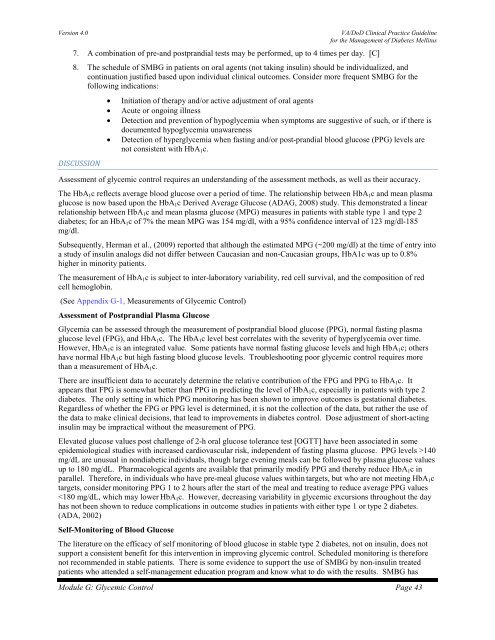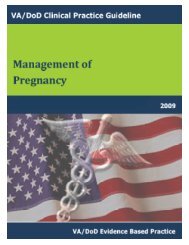DM Full Guideline (2010) - VA/DoD Clinical Practice Guidelines Home
DM Full Guideline (2010) - VA/DoD Clinical Practice Guidelines Home
DM Full Guideline (2010) - VA/DoD Clinical Practice Guidelines Home
You also want an ePaper? Increase the reach of your titles
YUMPU automatically turns print PDFs into web optimized ePapers that Google loves.
Version 4.0<br />
7. A combination of pre-and postprandial tests may be performed, up to 4 times per day. [C]<br />
<strong>VA</strong>/<strong>DoD</strong> <strong>Clinical</strong> <strong>Practice</strong> <strong>Guideline</strong><br />
for the Management of Diabetes Mellitus<br />
8. The schedule of SMBG in patients on oral agents (not taking insulin) should be individualized, and<br />
continuation justified based upon individual clinical outcomes. Consider more frequent SMBG for the<br />
following indications:<br />
DISCUSSION<br />
• Initiation of therapy and/or active adjustment of oral agents<br />
• Acute or ongoing illness<br />
• Detection and prevention of hypoglycemia when symptoms are suggestive of such, or if there is<br />
documented hypoglycemia unawareness<br />
• Detection of hyperglycemia when fasting and/or post-prandial blood glucose (PPG) levels are<br />
not consistent with HbA 1 c.<br />
Assessment of glycemic control requires an understanding of the assessment methods, as well as their accuracy.<br />
The HbA 1 c reflects average blood glucose over a period of time. The relationship between HbA 1 c and mean plasma<br />
glucose is now based upon the HbA 1 c Derived Average Glucose (ADAG, 2008) study. This demonstrated a linear<br />
relationship between HbA 1 c and mean plasma glucose (MPG) measures in patients with stable type 1 and type 2<br />
diabetes; for an HbA 1 c of 7% the mean MPG was 154 mg/dl, with a 95% confidence interval of 123 mg/dl-185<br />
mg/dl.<br />
Subsequently, Herman et al., (2009) reported that although the estimated MPG (~200 mg/dl) at the time of entry into<br />
a study of insulin analogs did not differ between Caucasian and non-Caucasian groups, HbA1c was up to 0.8%<br />
higher in minority patients.<br />
The measurement of HbA 1 c is subject to inter-laboratory variability, red cell survival, and the composition of red<br />
cell hemoglobin.<br />
(See Appendix G-1, Measurements of Glycemic Control)<br />
Assessment of Postprandial Plasma Glucose<br />
Glycemia can be assessed through the measurement of postprandial blood glucose (PPG), normal fasting plasma<br />
glucose level (FPG), and HbA 1 c. The HbA 1 c level best correlates with the severity of hyperglycemia over time.<br />
However, HbA 1 c is an integrated value. Some patients have normal fasting glucose levels and high HbA 1 c; others<br />
have normal HbA 1 c but high fasting blood glucose levels. Troubleshooting poor glycemic control requires more<br />
than a measurement of HbA 1 c.<br />
There are insufficient data to accurately determine the relative contribution of the FPG and PPG to HbA 1 c. It<br />
appears that FPG is somewhat better than PPG in predicting the level of HbA 1 c, especially in patients with type 2<br />
diabetes. The only setting in which PPG monitoring has been shown to improve outcomes is gestational diabetes.<br />
Regardless of whether the FPG or PPG level is determined, it is not the collection of the data, but rather the use of<br />
the data to make clinical decisions, that lead to improvements in diabetes control. Dose adjustment of short-acting<br />
insulin may be impractical without the measurement of PPG.<br />
Elevated glucose values post challenge of 2-h oral glucose tolerance test [OGTT] have been associated in some<br />
epidemiological studies with increased cardiovascular risk, independent of fasting plasma glucose. PPG levels >140<br />
mg/dL are unusual in nondiabetic individuals, though large evening meals can be followed by plasma glucose values<br />
up to 180 mg/dL. Pharmacological agents are available that primarily modify PPG and thereby reduce HbA 1 c in<br />
parallel. Therefore, in individuals who have pre-meal glucose values within targets, but who are not meeting HbA 1 c<br />
targets, consider monitoring PPG 1 to 2 hours after the start of the meal and treating to reduce average PPG values<br />
















